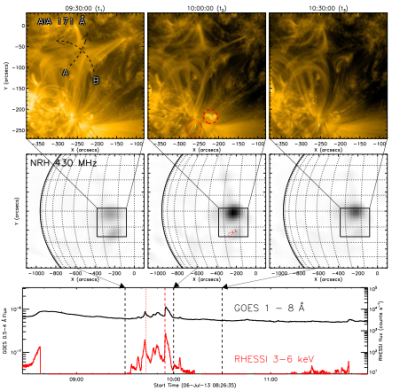3D Magnetic Reconnection at a Coronal Null Point
| Nugget | |
|---|---|
| Number: | 329 |
| 1st Author: | Shane Maloney |
| 2nd Author: | Aidan O'Flannagain and Peter Gallagher |
| Published: | 30 July 2018 |
| Next Nugget: | Understanding the co-spatial return current in solar flares |
| Previous Nugget: | The true dawn of multimessenger astronomy |
Introduction
Magnetic reconnection is believed to be the primary mechanism by which free energy stored in coronal magnetic fields is rapidly released during solar eruptive events. Unfortunately, owing to the small spatial scales on which reconnection is thought to occur, it is not directly observable by remote sensing of the solar corona. However, larger scale processes, such as associated inflows and outflows, plus signatures of accelerated particles, have been put forward as evidence of reconnection. Magnetic reconnection is often studied at X-points, the simplest view of the process in two dimensions.
In the case presented in this Nugget, we think instead that the reconnection occurs at a 3D coronal null point (Ref. [1]). This work employs data from many instruments: SDO/AIA, SDO/HMI, the Nançay Radioheliograph and GOES (as well as RHESSI), in a study of the partial collapse of a coronal structure associated with a Type I radio storm (.pdf). We interpret the observations as evidence for accelerated electrons in the reconnection region responding to a gradual fall and rapid rise in electric drift velocity, in response to the inflowing and outflowing field lines at a 3D null point.
Observations
Figure 1 shows SDO/AIA observations of the passage of an X-shaped feature from the limb towards disk centre. The X-shaped feature appears to undergo a partial collapse on 6 July 2013 at approximately 09:45. Before this collapse four loop structures are visible in 171 A channel while after the collapse the northern and western segments are no longer visible.

SDO/HMI observation were used as input for mpole multipole magnetic field extrapolation, the results of which are shown in Figure 2. The extrapolation shows an X-shaped feature which is consistent with the EUV observations. A combination of EUV observations and extrapolation results suggests that this feature is a coronal null point.

The Nançay Radioheliograph observations show a Type 1 noise storm associated with this region, with the radio imaging matching the X-shape feature in AIA 171 Â as it rotated across the disk. The NRH observations were further analysed to obtain the brightness temperature and longitudinal extent of the radio source see Fig 3 (bottom). Just before the collapse there is a small decrease in brightness temperature at all frequencies. During the collapse the is a simultaneous sharp rise in all frequencies which is followed by a peak in emission from higher frequency channels which moves to lower frequency channels over the subsequent 10 minutes. The extent of the radio source increases just before the collapse, before decreasing and returning to a similar value as before the collapse.

During the partial collapse soft X-ray emission was detected in
both RHESSI and GOES.
Figure 1 shows time profiles of the GOES 1-8 Â and RHESSI 3-6 keV channels.
Additionally RHESSI imaging allowed
the source to be localised to a region to the south of the X-shape
feature where a footpoint of one of the loops is believed to terminate.
Time-distance maps were extracted from the AIA data along to curved
segments as shown in Figure 1.
Gradual (1 km/s) and fast (5 km/s) inflow phases, as well as fast (30 km/s) and rapid (80-100 km/s) outflow
phases were found during the collapse (Figure 3).
The reconnection rate
can be estimated as MA = VIn/VA ~ VIn/VOut.
Using this approximation the reconnection rate was estimated as MA = 0.06.
Conclusions
A solar radio noise storm exhibited a close and consistent association with a quadrupolar transequatorial loop structure for its full passage across the disk. The interpretation of this noise storm as plasma emission produced indirectly by accelerated electrons at a 3D magnetic null point supports the idea that boundaries between interacting or transequatorial active regions are ideal locations for nonflaring reconnection due to their opposite magnetic polarity orientations (Ref. [2]).
Beyond this longterm relationship, we have investigated the behaviour of the radio sources during a rapid collapse of the 3D null point structure, as observed in AIA. We have interpreted the variation in radio brightness temperature as a fall and subsequent rise in accelerated electron population caused by the change in electric drift rate as magnetic fields are swept into and then out of the acceleration region. Our interpretation builds a complete picture of both nonflaring and impulsive reconnection by combining observations of coronal inflows and outflows at 3D null points with an associated signature of accelerated particles (Ref. [3]).
References
[1] "Three-dimensional magnetic reconnection in a collapsing coronal loop system"
[2] "The reconnection of magnetic field lines in the solar corona"
[3] "Particle acceleration at a three-dimensional reconnection site in the solar corona"